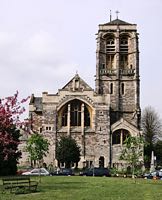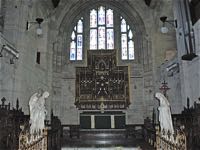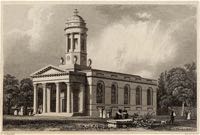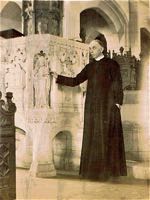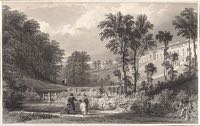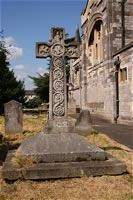
St David's Church
Page updated 2nd December 2015
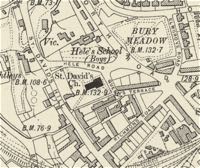 There has been a daughter
church of Heavitree on some rising ground that was known as St David's Dune since before Athelstane.
There has been a daughter
church of Heavitree on some rising ground that was known as St David's Dune since before Athelstane.
A deed of Bishop Henry Marshall of 1194, mentions, among others, St David's Church. Jenkins in his History of Exeter wrote of St David's Church in 1805:
"The church, which is situated on the summit of a hill, (called in ancient records St. David's Dune) is small and irregular, consisting of a nave and one aisle, without a chancel; the communion table being situated in the eastern angle of the nave. The whole of the building is remarkably low, as is the tower, which is square, containing four small untunable bells; the church is light, well seated, and kept-in good repair. The present edifice cannot lay claim to great antiquity, as it was built in the fifteenth century."
This church was demolished in 1813, and replaced by a Wren influenced, Greek Doric style by James Green. Green was familiar with Telford's, St Mary Magdalen Church, in Bridgenorth, and it is likely he was influenced by its design. The foundation stone was laid on the 4th June 1816, the birthday of George III, making the occasion, according to the newspapers, extra special. There is a brass plaque in the modern church that was taken from Green's church, that lists the many benifactors to the project. Iron Sam Kingdon was one such, who was also a church warden at the time. His foundry Kingdon and Sons (Garton and King) provided some of the iron work for the church. The main text on the plaque reads:
This first stone of the new church was laid by John William Williams Esq of Duryard(?) Lodge in this parish North(?) of Exeter on the 4th day of June 1816 the birthday of his Majesty George the Third and in the 56th year of his reign undertaken at the end of a war of 90(?) years in which Armies and Navy of Great Britain and her allies under Divine Providence were Victorious and by the ever memorable Battle of Waterloo the Downfall of Bonaparte the ruler of France was accomplished and the repose of Europe Re-established'
Those present then retired to the Barnstaple Inn, for a dinner, accompanied by a band playing several 'National airs'. Forty workmen from the construction were also invited, and they enjoyed a hearty Old English Fare of roast beef, plum pudding and strong beer. The committee then returned to the church to distribute loaves of bread and a quart of beer for 300 poor, to take home, and drink his Majesties health.
The church was consecrated on the 24 September 1817, by the Bishop of Exeter. A number of parishioners, along withe bishop and clergy dined at the New London Inn, where choice wines were served. Two corner stones bore the following inscriptions:
"This stone was laid Sept. Anno Domini 1817, by a Minister of Jesus Christ with the desire of rising an earthly Temple, in which may be proclaimed the great truth contained in the word of his mast .—1 Cor. Ch. 3. v.11.—'Other foundation can no man lay than that is laid, which is Jesus Christ.'"
"This buiding is intended for the use of the Messengers of that Gospel which declares a free and finished salvation in the Lord Jesus Christ, who is both the foundation and the head stone of the corner. Psalms 118. v. 22.—The Alpha and the Omega in the great work of bringing many sons to glory."
The octagonal tower was capped
by a
dome, giving it the nickname 'the
pepper pot church' because of the resemblance of its tower to a
Georgian silver pepper shaker. The organ was by Mr William Thomas of Exeter–the largest pipe was 12 ft long and 7 in in width. James Green, also built Elmfield
House, now the Imperial Hotel, was employed as the
County Surveyor. Green's church became dilapidated over the years. It was decided to rebuilt the church, and in June
1897, when the remaining structure was being demolished, a copper plate
was found embedded in a wall near the entrance. The plate listed
the names of the committee responsible for its construction, and was
placed there by Green in 1816. It was enlarged in 1839, by adding a transept with galleries on each side. The seating was increased by 600.
The present building was commissioned by the vicar, the Rev C J
Valpy
French, and designed by W D Caroe. Constructed of limestone, it was placed on the
same footprint as the old church to avoid the existing graves. The building work was completed and was consecrated by the Bishop of Exeter, on 9 January 1900. This time, the assembled great and the good retired to the Rougemont Hotel for a celebratory luncheon. In the evening, the workers were given a dinner at the Pack Horse Inn, adjacent to the church.
The cramped site forced Caroe to use internal buttressing, which he pierced to form aisles on each side. Half the £18,000 cost was funded by the Thornton West family. Sir John Betjeman wrote that it was "the finest example of Victorian church architecture in the south west".
The bells belong to the church of 1816, and have inscribed upon them 'T. Mears of London 1817'. On the corner stone at the north-east angle of the tower there is an inscription written by the Bishop Stubbs as follows:
Ad majorem Dei gloriam.
This stone was laid by Mrs Thornton West of Streatham Hall in
this parish on the 28th of July 1897, in the 1300th year of the mission
of St Augustine the Apostle of the English, in honour of St David
who about that time was maintaining the light of the Gospel among
the Britons, and in the 60th year of the reign of Queen Victoria, under
whom all nations of the Empire enjoy light and unity.
Thomas Glass (1709-1786), an influential Exeter Physician, who wrote of the disease of smallpox in 1767, is buried in the churchyard. Other notable graves are "Iron Sam" Kingdon, Kent Kingdon, Henry Frederick Willey and Paul Collings. Second Captain Alexander Cavalie Mercer who is also buried in St David's Churchyard, fought at the Battle of Waterloo. He was arguably the most famous officer who fought at Waterloo on 18th June 1815. He was acting commander of what was officially G (Dickson's) Troop, Royal Horse Artillery. His artillery was charged three times by the French, only for their artillery to cause mass casualties, and support the infantry on each side.
The yard was closed by Order in Council in March 1981, and put into the care of the City Parks Department. Some of the old gravestones have been moved to the side to make it easier to mow the grass. The green in the front of the church, on the corner of Hele Road and New North Road, was briefly used for allotments during the Second World War - when the enthusiastic gardeners started digging up skulls and leg bones, it was decided to close it and return it to grass.
The church is a Grade I listed building. In 2013, an appeal was opened for £300,000, as it was found to be suffering from subsidence.
Situated on the main road to North Devon, St David's was a poor
impoverished area after the Normans invaded because the Saxon
inhabitants
of the city were driven out to this area. The building of the
Ironbridge in 1832 and coming of the railway in 1845, saw a spate of
private
building along St David's Hill and the area became more prosperous.
The St David's Church 1914-1919 Roll of Honour
Alfred
Badcock
Wilfred Bagwill
Harry P Bartlett
Samuel A Beer
Clinton
A Blakeway
Alfred J Bond
Albert Boobyer
Reginald Bradford
Louis
Britton
Robert H Burns
Charles Burrows
Charles Burrows
Charles
W Butler
Edwin G Chenneour
Alfred J Cobley
Arthur Coombes
Francis
Court
Edmund C Crook
George C Curtis
Charles W Davis
Albert
G Dawson
John H Dean
William A Delve
George P Denham
Walter
T Downing
Ernest E Drew
Jack Evins
Paul D Farmer
Thomas W
Foster
Walter P Gammon
Frank Gillingham
William E Glasson
Percy
S G Godbear
Edgar J Grose
Ralph Hancock
Reginald Hawkins
George
Hawkins
Stanley Helmore
Albert E Holmes
Ronald Hoskins
Frederick
Johns
Rt V Kestall-Cornish
Frederick G King
Sidney
T King
William King
Jack Kneel
James H Loram
John Lyndon
Charles
H Matters
Edgar Melhuish
William S Middleton
Stanley Milton
George
Mitchell
John Nike
Herbert H Northcote
Albert Pine
Alfred C
Pinn
Henry Purfield
Percy Rawle
Morris Reardon
Clifford Reed
Joseph
C Rilot
Frederick Salter
George T Samball
Henry W Samball
Henry
E Shermer
Martin H Shorto
Abraham Smith
William S Spreadbury
Edwin
B Steele
Albert L Stentiford
Albert Street
Endlebert F Thole
Frank
L Thompson
John L Veitch
Dorothy Vlieland
Francis Vosper
John
A Webb
Louis J Webber
Arthur Whitton
Alfred Willmott
Frederick
willmott
John A Wyatt
Tom Rowe
George White
Sources: The British Newspaper Archive, GENUKI, Exeter Churches by Edith Cresswell, St David's Church website
Details of the ringing:
Sunday 22 June 2008
Exeter, St David
1288 Grandsire Triples in 41 minutes
Lesley A Tucker
1
Hilary
A Beresford 2
Susan
M Sawyer 3
P Wendy Campbell
4
Lester
J Yeo 5
Graham P Tucker
6
Donald
B Carter 7
Nigel G Birt
8
Conducted
by Donald B Carter
All are members of the Guild of Devonshire Ringers
│ Top of Page │
